
It's the time of year where many of you are hit with the boat buying bug.
It can be a daunting experience and costly if you don't prepare.
Here is an article based on one by Charles Fort.
Lessons Learned In Buying A Boat
Education and research helped make the purchase a smooth process.
After years of cruising and sailing, you decide it was time to trade it in. Suddenly you find yourself on the other side, you think you have extensive knowledge of the buying process, after all you read all the magazines and see and talk to everyone on the dock.
That may be true, but maybe you could still learn a few things that just may help you when it's time to go boat shopping.
Make sure you know what you want. Your boat-buying criteria: your must haves: type, age, amenities, and budget.
Lesson 1: Make a realistic offer.
After locating a suitable boat, don’t cheap out. If it seems super-clean and perfect. Make a good offer. Don’t assume a low-ball offer will be countered. All too often, another offer may already on the boat. Even if you raise your offer you may still lose your perfect boat for seemingly chump change.
So bid realistically, or you may lose the boat you want.
Lesson 2: Search deeper.
Exhausted the listings of two or three area yacht brokers, check out several local marina websites. You may find what your looking for.
Lesson 3: Educate yourself.
Research the vessel you are considering. Read every blog, forum, owner's manual, and service manual you can get your hands on. Watch videos. Check the Consumer Protection complaint database to see if the boat, engine, or dealership had any complaints.
Lesson 4: Negotiate.
Ask about current offers on the boat, and make what you consider a reasonable offer based on the facts. If the owners counter, make sure the offer is contingent on a satisfactory survey and sea trial.
Lesson 5: Focus on the big picture.
All used boats (and many new ones) will have some problems. You can't expect everything to be perfect. "If a sea trial and survey don't reveal anything serious or alarming, ( just the normal small items found on all surveys) it usually a good idea not to nitpick the sellers. The engine and other major systems on the boat should be the primary focus.
Lesson 6: Get it in writing.
If your offer includes repairs, get everything in writing. Make a list of what needs to be performed.
"Before settlement, get an invoice of items the sellers paid for. Read the boatyard's repair-warranty policy and make sure it transfers to a new owner. One more nugget: "There's no standard-length warranty for service work, and don't assume a yard is going to extend it if something breaks later. Check the work right away."
Lesson 7: A good dealer or broker will go the extra mile.
During our research, we learned that our dealer had a good reputation. The salesman spent an hour removing the old registration stickers for us, gave us some spare oil, flares, and a horn, and got the techs to power wash the cockpit carpet. I'd expect this more from a dealer who owned the boat, but consignment sales, where the sale is just based on a straight commission, often have less room for such extras."
Lesson 8: Go with a known entity.
An established repair facility can mean the difference between a day on the water and a day stuck at the dock. "The best thing you can do is to mitigate any surprises up front. Even a survey and sea trial are not guarantees that everything possible can be found, but without them, you may be faced with far more expensive repairs."
Lesson 9: Now educate yourself — some more.
If your invited us to join a class on boat maintenance for your new possession, or further education on things like docking and line handling, take them. Even if you're just moving up in size on the same kind of boat, maintenance and boat handling may be quite different from what you're used to.